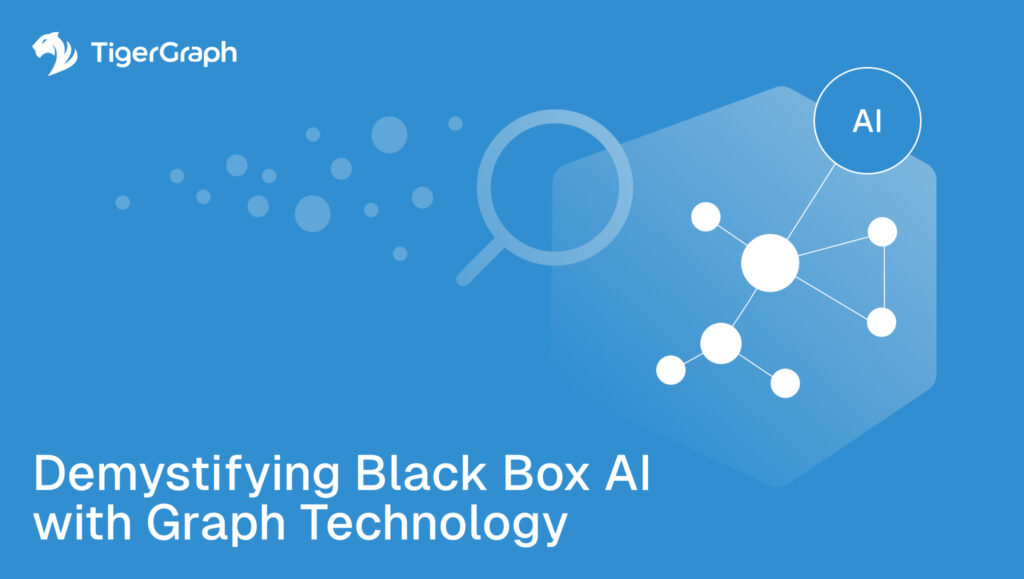Demystifying Black Box AI with Graph Technology
Artificial intelligence is reshaping how decisions are made—driving automation, accelerating insights, and enabling autonomy at scale. But with that power comes a growing concern: the Black Box problem.
As AI systems become more complex—especially those powered by deep learning—their decisions often lack transparency. They produce outcomes without showing the reasoning behind them. In everyday applications, this might be a mild frustration. But it’s a serious liability in high-stakes environments like finance, healthcare, and cybersecurity.
When an AI system denies a loan, flags a transaction, or recommends a treatment, the real question becomes: Why?
Why, indeed. We often don’t know, and today’s AI typically isn’t telling us.
That’s where graph technology changes the game.
The Black Box Problem: AI Without Accountability
Deep learning models are powerful tools for uncovering patterns, detecting anomalies, and making predictions. But they do so behind a wall of statistical abstraction. These models operate using millions—or even billions—of parameters, optimized through layers of training that often defy human intuition. The result is a system that can perform, but not easily explain.
This lack of transparency might be acceptable in low-stakes scenarios—recommending a movie, ranking a search result, or flagging spam. However, the stakes differ in regulated, safety-critical domains like finance, healthcare, and cybersecurity.
Opacity isn’t just a rare technical inconvenience. It’s not an “edge case” you plan for just in case something goes wrong. It’s the rule-breaking moment that regulators are already watching for.
Regulators aren’t trying to shut AI down—they’re trying to implement Responsible AI and keep it from hurting people, breaking laws, or operating without accountability. Their scrutiny is about protecting fairness, safety, and trust in an increasingly automated world. For example, in these industries:
- A flagged transaction can trigger a regulatory audit or freeze a customer’s account.
- A denied loan could impact someone’s livelihood.
- A misinterpreted medical recommendation could have life-altering consequences.
These are not theoretical concerns. They’re everyday scenarios—and each one demands explainability. Stakeholders need to know:
- Why did the system make that decision?
- What data informed it?
- Can the logic be reviewed, challenged, or improved?
In this context, a black box AI system becomes a liability. Not because it doesn’t work—but because no one can prove how it works when it matters most. That’s why building transparency and accountability into AI systems isn’t optional—it’s foundational.
Imagine a bank uses a deep learning model to detect credit card fraud. One morning, a customer’s transaction is flagged and their account is frozen. They call support, understandably upset—and the agent has no clear answer. The model scored the transaction as high risk, but can’t explain why.
Now imagine that same decision made within a graph-powered AI system. Instead of returning a cryptic risk score, the system shows a traceable path:
- The customer’s card was used from a device that’s also linked to multiple compromised accounts.
- The transaction was sent to a merchant involved in a previously detected laundering scheme.
- The pattern of usage deviates significantly from the customer’s typical behavior—traveling, transaction timing, and amount.
This layered, relational context gives the support agent an actionable explanation and gives compliance teams a defensible reason for the action taken. This is the difference between a system that acts and one that understands—and in regulated environments, that difference is everything.
Graph technology steps in to provide the missing structure and context that deep learning alone can’t deliver.
Graph as the Foundation for Explainable AI
Graph databases structure data as nodes (entities) and edges (relationships). This mirrors how we naturally reason—by connecting people, events, behaviors, and time. It enables AI systems to operate in a way that’s not only intelligent but interpretable, i.e., “explainable.”
Graph gives AI memory and context, and this is what lets agents reason and act responsibly. With graph technology, AI systems can:
- Trace the logical steps behind a decision.
- Visualize how entities and behaviors are linked across time.
- Embed and enforce rules and norms directly within a knowledge graph.
This means graph doesn’t just help AI think—it helps it justify. Another example could find us working with a healthcare diagnostic system. A traditional AI model might flag a patient as high risk for a rare cardiac condition but offer little explanation beyond a confidence score. A graph-powered system, however, can walk a physician through the logic:
- The patient shares multiple biomarkers with individuals previously diagnosed with the condition.
- There’s a family history connection revealed through linked patient profiles and genetic records.
- The patient’s recent lifestyle changes—captured in wearable data and wellness logs—mirror known risk trajectories from similar cases.
Instead of a black-box label, clinicians get a reasoned narrative. They understand not only what the AI sees, but why it matters. And that traceability becomes crucial when the diagnosis informs life-altering decisions, treatments, or follow-up testing.
Graph turns opaque predictions into transparent, trustable insights—whether you’re a doctor, an auditor, or a data scientist. It transforms AI from a black box into a glass box.
Explainability Is No Longer Optional
As AI becomes more powerful and more embedded in critical systems, the demand for explainable AI has gone from a best practice to a legal requirement. Governments and regulators are enacting frameworks like the EU AI Act, GDPR, and sector-specific mandates (such as Basel III in finance or HIPAA in healthcare) that require organizations to do more than just deploy AI—they must demonstrate how and why a system made a particular decision.
This means institutions must be able to:
- Show the logic behind an AI output—not just the result but the reasoning path that led there.
- Prove alignment with policies and laws—ensuring decisions don’t violate internal governance or external compliance standards.
- Audit systems for bias, fairness, and risk—so that organizations can explain outcomes to regulators, customers, or affected individuals, and correct them when necessary.
This level of accountability is difficult—if not impossible—with traditional black-box AI models operating in siloed, tabular data environments.
TigerGraph’s architecture is purpose-built for explainable, high-performance decision-making, offering:
- Parallel, distributed processing to query large datasets in real-time,
- Real-time graph traversal to follow relationships across multiple hops (think: tracing influence through people, transactions, behaviors, or devices),
- GSQL, an expressive and extensible query language that supports reusable logic and advanced pattern matching.
With TigerGraph, it’s possible to operationalize explainability. Whether an AI agent is making a credit decision, monitoring for cyber threats, or automating clinical insights, every action it takes can be justified through the graph—step by step, edge by edge.
In short: explainability isn’t a bolt-on feature. It’s built into the fabric of how TigerGraph is powering AI systems to see and act in the world.
Solving the AI Trust Problem with Graphs
The next wave of AI innovation isn’t just about bigger models. It’s about responsible autonomy with AI systems that act and explain; adapt and align. Agentic AI isn’t just about autonomy—it’s about responsibility, and it’s also about trust.
Graph is the missing piece that makes all of this possible. It gives AI systems a knowledge index, an ethical awareness, and a map of how things relate—so they can make decisions and also defend them. In the AI-powered future, trust isn’t just earned—it’s engineered.
Graph technology turns intelligence into explainable intelligence. It makes it possible for systems to adapt, reason, and operate transparently. And that’s what today’s enterprises, regulators, and users are demanding.
The question isn’t just what AI can do—it’s can we understand what it’s doing—and why? With graph, the answer is yes—and TigerGraph is the conduit to this understanding.

